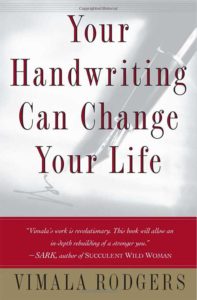The Vimala Alphabet

Vimala Rodgers, architect of the Vimala Alphabet™, has dedicated her life to teaching the benefits of healthy handwriting to students of all ages worldwide. In her groundbreaking work, she explains how alphabets and their writing systems reflect the attitudes and thinking patterns of the people who use them and the times they live in.
Because how we think is how we write, and, conversely, how we write is how we come to think, the Vimala Handwriting System™ incorporates positive, forward-thinking writing patterns. Its causal, simplified letters offer children a practical, enjoyable approach to cursive. And studies show children who enjoy writing learn better, faster and are higher achievers than those who don’t.

Created for the times we live in, the Vimala Alphabet™ integrates casual flowing lines that are both simplified and graceful. No clutter or pretentiousness here. Thoughts flow from the present and into the next moment. T-bars are atop the stem, far seeing. There is a good balance of angles and curves, mental and emotional energy. Uppercase letters are clean and uncluttered.
In her best selling book, Your Handwriting Can Change Your Life, author and handwriting expert Vimala Rodgers outlines a unique and practical approach to applying our own handwriting as a useful tool in fostering personal growth. Through her CD/book/cards set, Transform Your Life through Handwriting, she unveils deeper mysteries of the Alphabet.
Each time we press the pen to the paper to create a letter formation, connect letters, or shape a margin, we are declaring, ‘This is who I am.’
— Vimala Rodgers
Brief history of our modern Roman alphabet
Our Roman alphabet has a long history. Even in our modern times, cursive writing systems have evolved appreciably since the 1700’s. The Palmer Method was introduced in the late Nineteenth Century as a simpler alternative to the more ornate Spencerian Script. Charles Zaner gave us Zanerian Penmanship in the late 1800’s, and later he and Elmer Bloser partnered to found the Zaner-Bloser® Company and the writing system that came to bear its name. By the late 1970‘s some schools had adopted a more simplified system created by Donald Neal Thurber named the D’Nealian Style. Today, our 21st century life-styles have far outstretched these old models of thinking and writing. Vimala Rodgers designed The Vimala Handwriting System™ (also known as the Vimala Alphabet™) as the model for our 21st Century lifestyles.

Vimala Rodgers, Master Alphabetician and architect of the Vimala Alphabet™
About Vimala
Vimala Rodgers is a pioneer in the field of handwriting and the role of the hand-brain inter-connection. Research in the field of neuroscience supports the theory that the hand-brain connection, particularly the pen or pencil grip, affects, even creates, neural pathways in the brain. Neural pathways form the structure for our thinking patterns. How we write reflects how we think. Patterns in handwriting reflect patterns in thinking. Through many years of study, research, teaching, and helping others improve their lives by changing their handwriting, Vimala created a writing system that supports innate creativity and innovative thinking, supports perseverance, and reinforces inherent characteristics of positive, forward thinking patterns.
In simple terms, our writing patterns are clear indicators of how we feel about ourselves. They are a measure of our self-confidence, self-esteem, and self-reliance; they indicate our fears as well as our unique abilities.
— Vimala Rodgers
